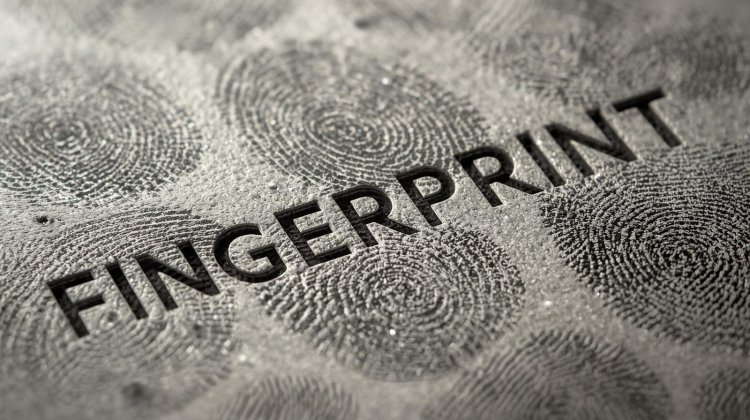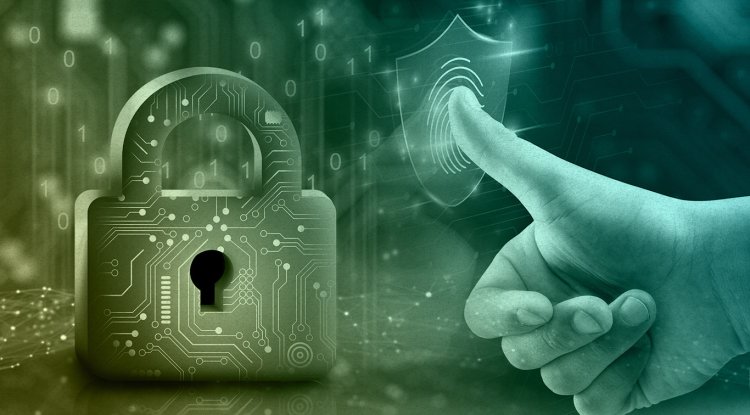Investigating the Future: Day 6 of International Forensic Science Week - FINGERPRINT
A crucial area of forensic science is fingerprint analysis, which uses the distinctive ridge and valley patterns on a person's fingertips to identify them. It is essential to civil identification, criminal investigations, and court cases.

Why Are Fingerprints Important?
-
Unique: No two individuals (even identical twins) have the same fingerprints.
-
Permanent: Fingerprints do not change throughout a person’s life.
-
Classifiable: Fingerprints can be systematically recorded and stored.
-
Easily Left Behind: They can be found on many surfaces — glass, metal, paper, skin, etc.
History and Development of Fingerprint
One of the earliest and most trustworthy ways to identify someone is through their fingerprints. From its ancient use for seals and signatures to its current use as a scientific and legal instrument in contemporary forensic investigations, its history spans thousands of years.
The father of fingerprint examination is Sir Francis Galton (1822–1911).
Why Sir Francis Galton?
-
He was the first to scientifically study and classify fingerprint patterns.
-
Published the landmark book “Finger Prints” (1892), which:
-
Established the uniqueness and permanence of fingerprints.
-
Introduced the basic classification system still used today.
-
-
He laid the scientific foundation for using fingerprints in personal identification and forensic investigations.
Other Important Pioneers
-
Sir William Herschel: First to use fingerprints for identity verification in India (mid-1800s).
-
Henry Faulds: Early advocate for fingerprint use in criminal investigations.
-
Sir Edward Henry: Developed the Henry Classification System used worldwide for filing fingerprints.
Fundamental Principles of Fingerprint Identification
Fingerprint identification is based on scientific principles that make fingerprints a reliable and legally accepted method of personal identification in forensic science.
There are four fundamental principles that form the foundation of fingerprint science
1. Principle of Uniqueness
-
Definition: No two individuals have identical fingerprints — not even identical twins.
-
Reason: The ridge patterns (minutiae points) and their arrangement are genetically influenced but formed by random pressure and movement in the womb.
-
Forensic Value: Allows absolute individualization of a person based on fingerprint evidence.
Example: Even if two people have the same fingerprint pattern type (e.g., loop), the minutiae arrangement (ridge endings, bifurcations, islands) will differ.
2. Principle of Permanence (Permanency)
-
Definition: Fingerprint patterns remain unchanged throughout a person's life.
-
Formed: In the fetal stage (around 10–16 weeks of gestation).
-
Destroyed only by: Deep injury damaging the dermal papillae (e.g., burns, cuts, surgery).
-
Forensic Value: Fingerprints can be used to identify living or deceased persons regardless of age.
Note: Even if the skin peels off, the new skin regenerates with the same pattern.
3. Principle of Comparison (Minutiae/Individual Characteristics)
-
Definition: Individual identification is based on the comparison of ridge characteristics (called minutiae points) such as:
-
Ridge endings
-
Bifurcations
-
Enclosures
-
Dots or islands
-
Short ridges
-
-
Minimum Matching Points: Many countries require a minimum number of matching minutiae (India typically uses 8 to 12+).
-
Forensic Value: This principle allows one-to-one matching and is crucial for establishing identity in court.
Types of Fingerprints (in Forensic Science)
Fingerprints can be classified based on pattern and appearance at the crime scene. These classifications are important for identification, comparison, and investigative use.
I. Based on Pattern – (Class Characteristics)
There are 3 major classes of fingerprint patterns, further divided into subtypes:
1. Loop (Most common – ~60–65% of people)
-
Ridge lines enter from one side, curve, and exit from the same side.
-
Contains one delta and a core.
-
Types:
-
Ulnar loop: Opens towards the little finger.
-
Radial loop: Opens towards the thumb.
- Ulnar and radial loops are named based on the bone on the corresponding side of the forearm.
-
2. Whorl (~30–35%)
-
Ridges form circular or spiral patterns.
-
Contains two deltas.
-
Types:
-
Plain Whorl
-
Central Pocket Loop Whorl
-
Double Loop Whorl
-
Accidental Whorl
-
A whorl must have at least one ridge making a complete circuit.
-
3. Arch (Least common – ~5–10%)
-
Ridges enter from one side and exit the other, no delta or core.
-
Types:
-
Plain Arch: Smooth rise in the center.
-
Tented Arch: Sharp upthrust or spike in the center.
-
Arches are the simplest and rarest patterns.
-
| Pattern | Subtypes | Features | Frequency |
|---|---|---|---|
| Loop | Ulnar, Radial | 1 delta, ridges enter and exit same side | 60–65% |
| Whorl | Plain, Central Pocket, Double Loop, Accidental | 2 deltas, circular/spiral ridges | 30–35% |
| Arch | Plain, Tented | No delta, ridges flow side to side | 5–10% |
II. Based on Visibility at Scene – (Crime Scene Classification)
1. Latent Fingerprints
-
Invisible to the naked eye.
-
Formed by sweat, oil, and other body secretions.
-
Detected using:
-
Powder dusting
-
Ninhydrin
-
Cyanoacrylate (superglue) fuming
-
UV or laser light
-
2. Patent Fingerprints
-
Visible prints.
-
Made by blood, ink, paint, dirt, or grease.
-
Directly seen on surfaces like glass, paper, or walls.
3. Plastic Fingerprints
-
3D impressions left in soft materials like
-
Wax
-
Soap
-
Butter
-
Wet paint
-
-
Can be photographed or cast using plaster.
Fingerprint Characteristics (Minutiae Points)
Fingerprint characteristics, also called minutiae, are the tiny details in the ridge patterns that make each fingerprint unique. These are the basis for individual identification in forensic science.
Common Types of Fingerprint Characteristics
| Characteristic | Description | Visual Clue |
|---|---|---|
| Ridge Ending | Where a ridge abruptly ends. | A line that stops suddenly. |
| Bifurcation | One ridge splits into two. | A fork or Y-shaped split. |
| Island (Dot) | A very short ridge that looks like a dot. | A tiny isolated ridge. |
| Enclosure (Lake) | A ridge that splits and reunites, forming an enclosed area. | Looks like an oval or eye shape. |
| Short Ridge (Independent Ridge) | A ridge that is significantly shorter than others. | A short ridge segment separate from others. |
| Bridge | A small ridge that connects two parallel ridges. | A tiny “bridge” between two ridges. |
| Spur | A bifurcation with one short ridge branching off. | A fork with a small branch. |
| Crossover | Two ridges cross each other forming an X-shape. | An X-shaped ridge crossing. |
| Double Bifurcation | Ridge splits into two, then one of those splits again. | A branching like a “Y” with another fork. |
Examination of Fingerprints
Fingerprint examination is a scientific process used to identify individuals based on the unique ridge patterns and minutiae of their fingerprints. It involves several steps to detect, record, analyze, and compare fingerprints from crime scenes and known samples.
Steps in Fingerprint Examination
1. Detection
-
Locate fingerprints at crime scenes or on objects.
-
Types of fingerprints:
-
Latent prints (invisible, formed by sweat/oil)
-
Patent prints (visible, e.g., blood, ink)
-
Plastic prints (impressions in soft materials like wax)
-
2. Development / Visualization
-
Make latent prints visible using methods such as:
-
Powder dusting (black, white, magnetic powders)
-
Chemical methods:
-
Ninhydrin (for porous surfaces like paper)
-
Cyanoacrylate (superglue fuming for non-porous surfaces)
-
Iodine fuming
-
-
Alternative light sources (UV light, lasers)
-
3. Collection / Recording
-
Once visible, fingerprints are:
-
Photographed for documentation.
-
Lifted using adhesive tape or other methods.
-
Digitally scanned for electronic storage (live scan).
-
4. Analysis
-
Study the fingerprint’s pattern type (loop, whorl, arch).
-
Examine the ridge details and minutiae (ridge endings, bifurcations, etc.).
-
Assess the quality and clarity of the print.
-
Evaluate if the print is suitable for comparison.
5. Comparison
-
Compare the crime scene print with known prints (suspect or database).
-
Look for matching minutiae points — position, type, and number.
-
The more matching points, the stronger the identification.
6. Evaluation
-
Decide if the fingerprints:
-
Match (identification)
-
Do not match (exclusion)
-
Are inconclusive (insufficient detail)
-
7. Verification
-
Another expert independently reviews the comparison for accuracy.
-
This step is crucial for maintaining scientific rigor and reliability.
8. Documentation and Reporting
-
Prepare detailed reports.
-
Present findings in court if required.
-
Include photographs, sketches, and description of the comparison.
Role of Fingerprints in Forensic Investigations
| Purpose | Description |
|---|---|
| Identification | Confirm the identity of victims, suspects, or unknown persons. |
| Crime Scene Linking | Place a suspect at the scene of a crime via latent prints. |
| Exclusion | Rule out individuals who do not match the fingerprint evidence. |
| Evidence Corroboration | Support other forensic evidence like DNA, ballistics, etc. |
| Cold Case Resolution | Help solve old cases using archived fingerprints and AFIS. |
Technological Advances
-
Automated Fingerprint Identification Systems (AFIS/NAFIS) allow rapid comparison with millions of records.
-
Digital scanning and enhancement improve latent print clarity.
-
Biometric integration (e.g., in law enforcement databases) speeds up identification.
-
Advanced chemical and physical methods reveal latent prints on difficult surfaces.
Follow cyberdeepakyadav.com on
Facebook, Twitter, LinkedIn, Instagram, and YouTube
What's Your Reaction?






















